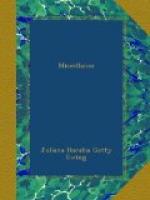It was under a palm that Deborah the prophetess sat when all Israel came up to her for judgment; and to an audience under the shadow of this tree, which bore her name, that she summoned Barak out of Kedesh-naphtali. Bethany means “the House of Dates,” and the branches of palm which the crowd cut down to strew before our Lord as He rode into Jerusalem were no doubt of this particular species.
Women—as well as places—were often named after the Princes of Vegetation, whose graceful and stately forms approved them to lovers and poets as fit types of feminine beauty.
Usefulness, however, even more than ornament, is the marked characteristic of the tribe. “From this order (Palmae),” says one writer, “are obtained wine, oil, wax, flour, sugar, salt, thread, utensils, weapons, habitations, and food”—a goodly list of the necessaries of life, to which one may add many smaller uses, such as that of “vegetable ivory” for a variety of purposes, and the materials for walking-sticks, canework, marine soap, &c., &c.
The Princes of Vegetation are to be found in all parts of the world where the climate is adapted to the tropical tastes of their Royal Highnesses.
They have come into our art, our literature, and our familiar knowledge from the East; but they abound in the tropics of the West, and some species are now common in South America whose original home was in India.
The cocoa-nut palm (Cocos nucifera) is an Indian and South Sea Islands Prince; but his sway extends now over all tropical countries. The cocoa-nut palm begins to bear fruit in from seven to eight years after planting, and it bears on for no less than seventy to eighty years.
Length of days, you see, as well as beauty and beneficence, mark this royal race which Linnaeus placed alone!
Cocoa-nuts are useful in many ways. The milk is pleasant, and in hot and thirsty countries is no doubt often a great boon. The white flesh—a familiar school-boy dainty—is eaten raw and cooked. It produces oil, and is used in the manufacture of stearine candles. It is also used to make marine soap, which will lather in salt water. The wood of the palm is used for ornamental joinery, the leaves for thatch and basket-work, the fibre for cordage and cocoa-nut matting, and the husk for fuel and brushes.
Cocoa and chocolate come from another palm (Theobroma cacao), which is cultivated largely in South America and the West Indies.
Sago and tapioca are made from the starch yielded by several species of palm. The little round balls of sago are formed from a white powder (sago flour, as it is called), just as homoeopathic pillules are formed from sugar. It is possible to see chemists make pills from boluses to globules, but the Malay Indians are said jealously to keep the process of “pearling” sago a trade secret. Tapioca is only another form of sago starch. Sago flour is now imported into England in considerable quantities. It is used for “dressing” calicoes.




